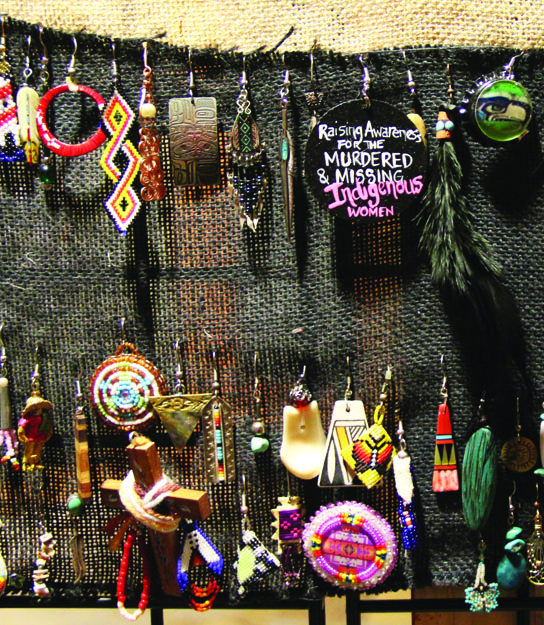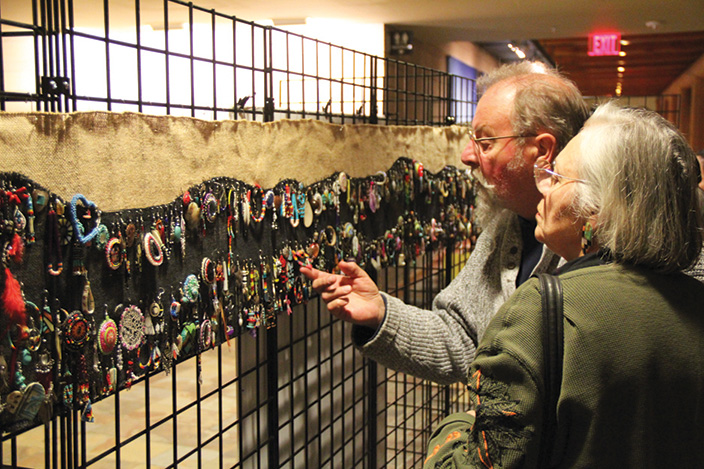Month: January 2016
Hibulb Cultural Center debuts Sing Our Rivers Red

by Micheal Rios, Tulalip News
The reality. Since 1980, over 1,181 Native women and girls in Canada have been reported missing or have been murdered. While there isn’t a comprehensive estimate, there are many factors that contribute to the disproportionate number of Indigenous women who are missing and murdered in the United States.
Indigenous women have incurred devastating levels of violence in the United States. According to the US Department of Justice, nearly half of all Native American women have been raped, beaten or stalked by an intimate partner; one in three will be raped in their lifetime; and on some reservations, women are murdered at a rate 10 times higher than the national average. But many factors complicate the reporting and recording of these numbers, including fear, stigma, legal barriers, racism, sexism, and the perpetuation of Native women as sexual objects in mainstream media.

The exhibit. On Friday, January 8, the Hibulb Cultural Center and Natural History Preserve debuted the travelling earing exhibition, Sing Our Rivers Red, created by Diné (Navajo) and Chicana artist Nanibah “Nani” Chacon. The exhibition uses 1,181 single-sided earrings to represent the Indigenous women reported murdered and missing in both Canada and the United States. Nani’s intention is to use the power of this art piece to raise awareness about this epidemic that occurs in the United States and all across Turtle Island. Over 3,406 earring were donated from over 400 people, organizations, groups, and entities from six provinces in Canada and 45 states in the U.S.
Former Board of Director, Deborah Parker, who had an immense role in the 2013 Violence Against Women Act (VAWA) reauthorization, was present to witness the exhibit debut and speak on its importance.
“I thank everyone here for honoring the work that’s been going on, for honoring all the missing and murdered Indigenous women who are represented by these earrings. I know for some of us this is a difficult issue to even talk about,” said Parker. “When we talk about policy, protecting, and justice for missing and murdered Indigenous women there’s not always the words that can be said to fight on behalf of those who cannot speak. I know this is such a somber, such a hard issue to think about, but it’s so important for us to discuss. So I really want to honor each and every one of you who are here tonight because you are part of the story, you are part of the prayers, and I’m hoping and praying you are part of the solution.
“This exhibit is a good way to open up that dialogue and discuss the issues represented in this art and those earrings. We no longer have to remain silent. I strongly believe when we speak of the missing and murdered Indigenous women that we honor them on the other side, we honor their name and their presence. They deserve to be honored and to be talked about in a way that will bring justice because no one deserves to go missing from their families, no one deserves to be murdered. Hopefully, we leave this exhibit feeling motivated to stand up and to speak out for justice.”
Before closing the evening’s debut, several strong and motivated Tulalip women donated earrings and shared words of their importance. The earrings will join the many others that represent and speak for those who can’t speak for themselves.
Board of Director, Theresa Sheldon, was one of those who donated earrings to the exhibit. “Planting those seeds of change right now is just the beginning. Making it a regular conversation with people, finding where it is that you are comfortable to discuss these issues, and learning how to further the conversation helps victims become survivors,” explained Sheldon. “I truly thank you all for answering the call and being here. Please share what you witnessed tonight and carry on the words that were shared and know that you can make a difference. By sharing these messages and breaking the cycle of silence you have that ability to provide opportunities for healing.”

The mission. The Sing Our Rivers Red exhibition and events aim to bring awareness to the epidemic of missing and murdered Indigenous women and colonial-gender based violence in the United States and Canada. The events strive to raise consciousness, unite ideas and demand action for Indigenous women and girls who have been murdered or gone missing, raped, and assaulted, and who have not received the proper attention and justice.
Sing Our Rivers Red stands in solidarity and with collaborative spirit to support the efforts built in Canada and to highlight the need for awareness and action to address colonial gender violence in the United States. The events recognize that each of us has a voice to not only speak out about the injustices against our sisters, but also use the strength of those voices to sing for our healing. Water is the source of life and so are women. We are connecting our support through the land and waters across the border: we need to “Sing Our Rivers Red” to remember the missing and murdered and those who are metaphorically drowning in injustices.

Sing Our Rivers Red will be on display at the Hibulb Cultural Center through the end of the month. For hours and directions, please visit HibulbCulturalCenter.org
Father of Marysville Pilchuck shooter sentenced to 2 years
By Rikki King, The Herald
SEATTLE — The Tulalip man whose teenage son killed four students and himself at Marysville Pilchuck High School in 2014 was sentenced to two years in federal prison Monday.
Raymond Fryberg, 42, stood up in U.S. District Court and expressed sorrow over the violence his son wreaked using a handgun the elder Fryberg could not legally possess.
Fryberg told U.S. District Judge James Robart he wakes up every day with a broken heart and prays for the young lives lost.
“I am sorry for what my son did,” he said. “ … I don’t condone any of the things my son did. It’s a tragedy.”
A federal jury in September convicted Fryberg of six counts of illegal firearm possession. He was the subject of a 2002 domestic-violence protection order in Tulalip Tribal Court that forbade him from owning guns.
Assistant U.S. attorneys sought roughly three years in prison, the stiffest punishment under sentencing guidelines. Fryberg’s defense attorneys, however, argued the man and his family had suffered enough. They urged two years of probation, with no time behind bars.
An investigation after the Oct. 24, 2014, shootings found the elder Fryberg had repeatedly filled out federal forms while buying 10 different guns and never once answered truthfully that he was disqualified from making such purchases. The defendant’s son used his dad’s illegally acquired .40-caliber handgun to open fire in a high school cafeteria. Before taking his own life, the teen shot five of his friends and relatives. Only Nate Hatch, shot in the jaw, survived.
On Monday Nate’s mother, Denise Hatch, told the court that in the 15 months since the shootings Raymond Fryberg had never apologized, and that lack of apology had divided the community.
Fryberg told Judge Robart that he went to trial on the charges in hopes of preserving his right to own weapons necessary for hunting, which he said is integral to tribal culture.
Under federal sentencing guidelines, Fryberg faced a presumed punishment of between 27 and 33 months.
He was not immediately taken into custody Monday.
Tulalip Resort Casino Appoints Jeremy Taisey as Chef/GM of their AAA Four Diamond Tulalip Bay Restaurant
Source: Allan Aquila & Associates, LLC
Tulalip, Washington — Tulalip Resort Casino is pleased to announce the appointment of Jeremy Taisey as the new Chef/GM of their Four Diamond Tulalip Bay Restaurant — bringing new vision and experience to the operation. Prior to joining the Resort’s culinary team, Jeremy Taisey was cooking up cutting-edge fare at the Woodmark Hotel Kirkland, Las Vegas’ Bellagio Hotel, The Regent Hotel Beijing, along with the Pine Valley Resort in Beijing and other local area hotels.
“We are excited to bring Jeremy Taisey on-board,” states Executive Chef Perry Mascitti. “He possesses an incredible mixture of knowledge, creativity, and foresight that he will bring to the operation. Our guests are going to enjoy what he creates for them.”
Native to the Seattle area, Jeremy Taisey has always been fascinated by the happenings in the kitchen. It was during an Easter brunch at a local hotel that he decided to become a chef. The next day, Jeremy Taisey enrolled himself in the Edmonds Community College Culinary Arts program, which allowed him to fulfill his dream.
In 2006, Jeremy Taisey decided to pack his belongings and venture to Beijing, China, to marry his fiancé of three years. It was during his time in China that Jeremy Taisey’s career really took off. During his nomadic culinary journey, he cooked for many famous individuals, such as the Governor of Beijing, Israel’s Prime Minister, the Princess of Thailand, and actors Jackie Chan, Jet Li, and Christopher Lloyd.
Jeremy Taisey returned to his hometown in 2012, bringing with him a blend of unique experiences and an unparalleled skill set. His goals for the Tulalip Bay menu are to create seasonal dishes featuring modern interpretations of Italian meals, using local ingredients with a focus on top-rated prime steaks.
When Jeremy Taisey isn’t cooking up a storm in the kitchen, he can be found spending quality time with his wife and enjoying great food.
January 13, 2016 syəcəb
Click on the below link to download the January 13, 2016 issue of the syəcəb
January 13, 2016 syəcəb
“Being Frank” More Salmon Habitat Protection Needed
By Lorraine Loomis, Chair, Northwest Indian Fisheries Commission
We’ve seen some incredible salmon habitat restoration projects the past few years, but there’s a big difference between restoring habitat and protecting it. We must remember that restoration without protection does not lead us to recovery.
The Elwha River on the Olympic Peninsula continues to heal itself after the largest dam removal effort in U.S. history. Two dams on the river had blocked salmon migration and denied Lower Elwha Klallam Tribe’s treaty fishing rights for more than 100 years.
In another big project, the Tulalip Tribes and partners recently returned tidal flow to the 400-acre Qwuloolt Estuary. The estuary was drained and diked for farming in the early 1900s, blocking access to important salmon habitat.
Both were huge, costly projects that took decades of cooperation to accomplish. Every habitat restoration project – large or small – contributes to salmon recovery. But if we are going to achieve recovery, we must do an equally good job of protecting habitat, and that is not happening.
Treaty Indian tribes are seeking federal leadership to help turn this tide.
Salmon recovery efforts cross many federal, state and local jurisdictions, but it is the federal government that has both the legal and trust responsibility to recover salmon and honor tribal treaty-reserved rights. Through our Treaty Rights at Risk initiative, we are asking the federal government to lead a more coordinated and effective salmon recovery effort.
One way is to ensure that existing federal agency rules and regulations do not conflict with salmon recovery goals.
An example is the U.S. Army Corps of Engineers’ jurisdictional boundary they use for permitting shoreline modifications. The Corps regulates construction of docks and bulkheads in marine waters, and uses a high water mark based on an average of each day’s two high tides to determine its jurisdiction under the Clean Water Act.
But the Clean Water Act specifies the protection boundary should be the single highest point that an incoming tide can reach.
In Puget Sound, the Corps’ boundary is 1.5 to 2.5 feet below the highest tide. When you apply that to 2,000 miles tidelands, a large portion of important nearshore habitat is left unprotected.
That needs to change. We need to be protecting more habitat, not less.
Another example is agricultural easements issued by the federal Natural Resources Conservation Service that can block salmon habitat restoration efforts.
Federally funded agricultural easements pay landowners to lock in agricultural land uses permanently, regardless of whether those areas historically provided salmon habitat and need to be restored to support recovery.
The federal government needs to change the program to ensure agricultural easements do not restrict habitat restoration and other salmon recovery efforts.
These are just a couple of examples of how federal actions can conflict with salmon recovery goals to slow and sometimes stall our progress.
We know that habitat is the key to salmon recovery. That’s why we focus so much of our effort on restoring and protecting it. Many amazing restoration projects are being accomplished, but the more challenging task of protecting that habitat is falling short.
We must do everything we can to protect our remaining habitat as we work to restore even more. One way to do that is to harmonize federal actions and make certain they contribute effectively to recovering salmon, recognizing tribal treaty rights and protecting natural resources for everyone.
Lady Hawks continue dominant season with 58-38

by Micheal Rios, Tulalip News
On Monday, January 5, the Tulalip Heritage Lady Hawks (8-0) hosted the Lopez Lobos (2-4) at Francy J. Sheldon gymnasium. For the Lady Hawks, it’s been smooth sailing through the first eight games of the season. Owners of an undefeated record and winning by an average margin of 24 points, the Lady Hawks are on a dominating form of cruise control.
The dominance has been showcased on both ends of the floor, as they are averaging a league high 52 points per game while holding their opponents to a measly 29 points per game.
In the 1st quarter of Monday’s game, the Lady Hawks displayed everything that’s been working for them thus far. They were able to work the ball inside to Adiya Jones and Cyena Fryberg at will, their ability to draw a double team opens up wide open looks for wing players, and those wings have been knocking down the good looks. Then on the defensive end, the Lady Hawks use a nice combination of 2-3 zone and full court press to either force their opponents into a highly contested jump shot or a turnover. The home team led 17-9 at the end of the quarter.

In the 2nd quarter, guard Keryn Parks caught fire from 3-point land, making three straight 3-pointers. Aliya Jones chipped in a 3-pointer of her own, while Adiya started to have her way inside scoring three fields goals in the paint. Defensively, the Lady Hawks were putting on a clinic. It seemed like every other possession they would come up with a steal or block. Forcing so many turnovers left the Lobos dazzled and they weren’t able to do much scoring. At halftime the home team had a 20 point lead, 38-18.
During the 2nd half, with such a large lead, coach Bubba Fryberg was afforded the opportunity to give his bench players some heavy minutes. It was good a learning experience for the Lady Hawk reserves as they tried to run their offensive sets while remaining active on the defensive end.
When the final game buzzer sounded, the Lady Hawks had moved to 9-0 on the season with a 58-38 win. Keryn led all scorers with a career best 21 points, while Adiya filled the box score with 13 points, 14 rebounds, 4 assists, 5 steals and 5 blocks.
Contact Micheal Rios, mrios@tulaliptribes-nsn.gov
Hawks on 3-game win streak, beat Lobos 59-33

by Micheal Rios, Tulalip News
After a disappointing 1-5 start, the Tulalip Heritage Hawks have turned their season around with a 3-game win streak. Their latest win came at home on Monday, January 5, when they hosted the Lobos of Lopez Island.
Defensively, the Hawks opened the game with active hands and constant movement. They contested every Lobos shot and forced several turnovers that they were able to turn into easy transition points. The Hawks rode the hot hand of Josh Iukes, 13 points in the first half, and their suffocating team defense to the tune of a 30-9 halftime lead.
The game would tighten up in the 2nd half. However, seniors Robert Miles, Jr. and Willy Enick put the offense on their backs and combined to score 21 points down the stretch to secure the victory. The 59-33 win moved the Hawks record to 4-5 on the season and only 1 game below .500.
New Look in the New Year for Tulalip’s hotel

Photo/Micheal Rios
By Micheal Rios, Tulalip News
A new year brings hope. A new year triggers a desire to change an aspect of your life. An optimistic spirit of “new year, new me” motivates many to make a New Year’s resolution. Even the casual social media user had their timeline plastered with New Year’s resolution aims, goals, lyrics, or memes. Most people declared to do more or less of something in their day-to-day lives, such as eating healthier, exercising on a regular basis, losing weight, quitting a bad habit, or learning how to better manage money.
Well, as a brand and as a resort destination, the Tulalip Resort Casino has made a New Year’s resolution of its own: to return as the standard bearer for luxury accommodations that balance artistry, stylish elegance, and an abundance of comfort.
When the Tulalip Resort Casino (TRC) opened in May 2008 there was no question who had the most luxurious accommodations in the area, it was Tulalip. Fast-forward nearly eight years to the present and the TRC no longer stands head and shoulders above the rest. Over the past eight years, many tribes in the state have followed Tulalip’s lead and built their own resort casinos. Those with standalone casinos have added a hotel, those with a subpar hotel have upped their game by remodeling, and then there are the tribes who decided to enter the gaming world and invest in newly constructed resort casinos. All this is to say Tulalip now has competition where once there wasn’t any.
“Since we’ve opened our tower and been operating the Tulalip Resort Casino, we’ve seen Swinomish open their property, Silver Reef has opened their second tower, Angels has opened their new property, and Clear Water has added a tower,” explains Sam Askew, General Manager of Tulalip’s “four-diamond rated” hotel. “The competition, in terms of gaming within the state, have all upped their game because they want to emulate what Tulalip has done and continues to do.”
Over the past eight years, the accommodations industry has seen trends change and upgrades in technology, furnishings, and in-room amenities that are now in demand by today’s guests. Frequent guests of resort casinos can notice the difference in room quality from an out of date accommodation, as do tribal members who have stayed at other newly minted hotels in the region. Because of this, the Tulalip Board of Directors and TRC executive staff deemed it time to renovate the hotel guest rooms and bring back the WOW-factor that Tulalip is known for.
Of the two new room designs to be implemented in the renovation, it’s the Tulalip design that will be most prevalent. The Tulalip room design is self-evident; everything from the predominantly red and black color scheme, styling, design elements, artwork and even the carpet graphics have you feel like you are at Tulalip. Everything in this room is designed and geared for Tulalip culture and history, whether it’s a weaving token, fishing reference, or a stunning piece of artwork created by Tulalip artists James Madison and Joe Gobin.
Bringing back the WOW-factor to the guest rooms will include introducing many new enhancements to each room.
“One of the interesting things, too, is that most of the guest enhancements in the new rooms come from a culmination of guest requests and suggestions, recommendations from our facility and maintenance teams, and our continued mission to provide the best service we can,” says GM Sam Askew. “Guest enhancements include an improved heating and cooling system, in-room refrigerator, lowered countertops, vessel sinks, improved ventilation in the bathroom, new electrical outlets with USB ports to charge your electronic devices, faster in-room WiFi, and all TVs will be smart TVs with over 100 channels provided by Tulalip Broadband. There will also be smart media hubs in each room so that you can hook up a gaming system, tablet or even PC to the TV. We’ve also got state of the art Bluetooth enabled smart mirrors in the bathroom, so you can listen to your favorite music while enjoying Tulalip’s famous shower.”
So from a whole new design with new and upgraded technology, furnishings, and amenities that will make guests have no doubt they are staying in Tulalip, to a whole list of guest enhancements that will continue to grow as renovation is underway and new ideas are introduced, Tulalip will be getting its WOW back.
“For us, I think the big takeaway will be the rooms clearly identified as Tulalip. There will be no ifs, ands, or buts about it, when you see the room you’ll know it’s a Tulalip room. I’m proud of that,” continues GM Sam Askew. “In our industry most people go with safe and comfortable, but here we’re able to go with WOW and a sense of heritage and belonging. For me, that part is the best. It demonstrates the culture of service we are known for at Tulalip and it also demonstrates the Tribes long-term commitment and vision.”
TRC guest room renovation is currently underway and estimated completion is March 31, 2017. Be sure to follow Tulalip News on Facebook for updates as the renovation is ongoing.
Tulalips, Forterra to preserve land near Wallace River for salmon
By Chris Winters, The Herald
GOLD BAR — A 1.25-mile stretch of forested land along the Wallace River will now be protected forever as salmon habitat.
The land, covering 121 acres on five parcels, was purchased by the environmental nonprofit Forterra in July for $490,000. Forterra, formerly known as the Cascade Land Conservancy, transferred the property to the Tulalip Tribes in November for future management.
A conservation easement ensures the property will never be developed.
“There’s a stewardship plan that we’ll be working on with the Tulalips” to maintain the tract’s value to the watershed, said Michelle Connor, Forterra’s executive vice president of strategic enterprises.
The property on the north bank of the Wallace River consists of five parcels that are a mix of wetlands and mature second-growth forests. It was last logged several decades ago.
“The trees have grown back nicely and the land is actually in pretty good shape,” said Daryl Williams, the Tulalip Tribes’ natural resources liaison.
The tract is located just west of Gold Bar and close to the Mt. Baker-Snoqualmie National Forest, the Wild Sky Wilderness and other protected lands managed by the state Department of Natural Resources.
The land lies across the Wallace River from a state salmon hatchery, and provides habitat for bull trout as well as four types of salmon: chinook, coho, pink and chum. The land is also home to black bear, elk, deer and beaver.
Williams said the land is likely to remain in its present state, as it already provides ideal habitat for fish in the water as well as for land mammals.
“Right now we don’t have any money to do anything with the property,” Williams said. “Perhaps we’ll thin some of the trees to allow some of the others to grow faster.”
The deal came together when Forterra learned the owner of the parcels, a property investment firm called Robinett Holdings, soon would put them up for sale, Connor said.
“When we first learned the property was coming on the market, we contacted the Tulalip Tribes to see if (the land) would be conservationally significant,” Connor said.
That turned out to be the case, she said.
“The property itself has historical oxbows and natural features that in and of themselves are very, very important,” she said.
It also fit in with the Tulalips’ efforts to restore the watersheds associated with the Snohomish, Skykomish and Snoqualmie rivers.
“We’ve been spending a lot of time and effort trying to restore areas on the watershed,” Williams said.
“With new development and redevelopment, we’re losing habitat faster than we’re replacing it,” he said. “We need to do a better job with what we have.”
The deal marks the second large habitat protection project the Tulalips have undertaken. Last year the tribes breached the levees and restored tidal influence to the Qwuloolt Estuary in Marysville. The 315-acre tract took 20 years to convert from farmland to a salt marsh and cost nearly $20 million.
The transfer of the Wallace River tract is also consistent with Forterra’s goals in working with local Native American tribes on preservation, Connor said.
Last year Forterra carried out a similar property transfer with the Makah Tribe involving 240 acres near Lake Ozette on the Olympic Peninsula that is considered critical salmon habitat.
“We see that repatriation of indigenous lands is an important part of our conservation mission,” Connor said.
Snohomish County was the primary provider of funds for the land purchase and transfer, providing $280,000 in Conservation Futures funds toward the purchase, and toward other costs associated with obtaining the conservation easements and transferring the property to the tribes.
County Parks Director Tom Teigen said the Conservation Futures Advisory Board often tries to strike a balance between acquiring land for active recreation, agriculture and habitat preservation, but this particular exchange stood out for its potential benefits to salmon.
“At the end of the day, preserving that property and getting that much acreage as well as the riverfront is significant,” Teigen said.
Forterra also received $250,000 from the state Recreation and Conservation Office toward the property purchase.













